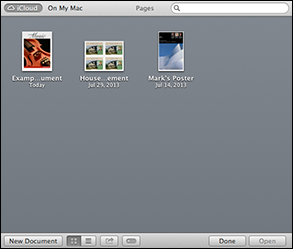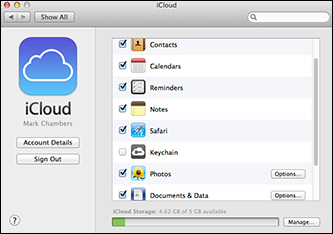Chapter 11
Expanding Your Horizons with iCloud
In This Chapter
![]() Introducing iCloud
Introducing iCloud
![]() Setting iCloud preferences
Setting iCloud preferences
![]() Managing iCloud storage
Managing iCloud storage
If you ask the average iMac owner what’s available on the Internet, you likely hear benefits such as e-mail, photo storage, web surfing, and Google searches. What you may not hear is “instant syncing and document sharing among all my Apple iOS devices, Macs, and even PCs.”
If you have an iPhone, iPad, or iPod touch, you may have experienced what I like to call the “Synchronizing Blues”: When you took a photo with your iPhone or created a new document with your iPad, your new additions just sat there (in their original location) until you had a chance to sync your device with your iMac. Ah, but with Apple’s iCloud functionality, your stuff gets automatically synchronized across the Internet!
In this chapter, I show you what’s really exciting about your iMac and that fancy Internet connection. With iCloud, you can automatically synchronize your stuff, access your documents with any Internet connection, and manage online backups of all your contacts, calendars, mail, bookmarks, and documents!
So How Does iCloud Work, Anyway?
Today’s Apple iOS devices can all display or play the same media: photos, music, books, TV shows, and such. Heck, some iOS devices (such as your iPhone and iPod touch) can even share applications that you install. Therefore, it makes sense to effortlessly share all your digital media across these devices, and that’s what iCloud is all about. Apple calls this synchronization “pushing.”
Here’s a look at how the pushing process works. Imagine that you just completed a Pages document on your iMac (an invitation for your son’s birthday party), but you’re at the office, and you need to get the document to your family so that they can edit and print it using your son’s iPad.
Before iCloud, you had to attach the document to an e-mail message or upload it to some type of online storage (such as Dropbox or Microsoft SkyDrive), and then a family member had to download and save the document to the iPad before working with it. With iCloud, you simply save the document on your iMac to your iCloud Library, and OS X automatically pushes the document to the iPad! Your document appears on the iPad, ready to be opened, edited, and printed — and it appears on any other devices running iOS 5 or later (using the same Apple ID) as well. Figure 11-1 gives you an idea of what’s happening in the background when one of your devices pushes data using iCloud.

Figure 11-1: iCloud works by pushing data among all your iOS devices.
And iCloud isn’t limited to just digital media. Your iMac can also automatically synchronize your e-mail accounts, Calendar calendars and events, and Contacts entries with other iOS 5 or later devices across the Internet, so staying in touch is much easier no matter where you are, or which device you happen to be using at the moment.
Apple also throws in 5GB of free online storage that you can use for all sorts of things: not only digital media files but also documents that you’d like to save online for safekeeping. Items you buy through the iTunes Store — music, video, and applications — and the images in your Photo Stream do not count against your free 5GB limit. (More on how you can expand that 5GB limit later in the chapter.)
Saving and Opening iCloud Documents
iCloud online storage for your documents is definitely neat. However, if you’re used to using Dropbox, you’ll find that the functionality of saving and opening files is somewhat different with iCloud. Dropbox allows you to use Finder to access your online Dropbox files (just like your iMac’s internal drive), but iCloud allows you to save, open, move, and delete files only from within Mavericks applications.
In other words, you can’t copy a Numbers project from your iCloud Library directly to a Finder window. You can open it, delete it, or move it by dragging it from the Open dialog to your iMac’s drive, but otherwise that document remains firmly entrenched in your iCloud Library. You also can’t copy files (such as an image file you create with Disk Utility) directly into your iCloud Library. You can save documents to your iCloud Library only from applications that support iCloud.
Figure 11-2 illustrates an iCloud Library Open dialog in action — in this case, the Open dialog from Pages.

Figure 11-2: I’ve stored three Pages documents in my iCloud Library.
Configuring iCloud
You control all the settings for iCloud from Mavericks’ iCloud pane in System Preferences (shown in Figure 11-3). Click the System Preferences icon on the Dock and then click the iCloud icon. At the sign-in prompt, enter your Apple ID and your password. System Preferences will then guide you through basic iCloud configuration.

Figure 11-3: The iCloud pane appears within System Preferences.
Most of the check boxes on the iCloud Preferences pane control whether a particular type of data — such as a Contacts entry, password, Mail account, Keychain password, or calendar in Calendar — is pushed among all your iOS devices. You can also disable the Documents & Data check box to return to the original File Open dialog, with no access to your iCloud Library. (Alternatively, you can specify which applications will have access to your iCloud Library by clicking the Options button.)
Note, however, that you can enable three other unique features from this pane as well:
- Photos: Click the Options button here and enable the My Photo Stream check box to allow your Mac to automatically receive photos from your iOS devices. Take a photo with your iPhone, for example, and that image is immediately pushed to your Mac, iPad, and iPod touch. On the Mac, however, Photo Stream goes one step further: The photos appear automatically in iPhoto or Aperture in a special album titled Photo Stream.
 To turn on Photo Stream in iPhoto, choose iPhoto⇒Preferences, click the Photo Stream button, and then select all three check boxes. My Photo Stream must also be selected in the iCloud Preferences pane.
To turn on Photo Stream in iPhoto, choose iPhoto⇒Preferences, click the Photo Stream button, and then select all three check boxes. My Photo Stream must also be selected in the iCloud Preferences pane. - Back to My Mac: If you enable Back to My Mac, you can remotely control your iMac from another Mac computer (or vice versa) using Mavericks’ Screen Sharing feature. You can also transfer files between the two computers. Back to My Mac works over a broadband Internet connection or a local network (LAN). Available Mac computers show up in the Shared section of the Finder window sidebar. Note that you must manually turn on Screen Sharing in the System Preferences Sharing pane before you can remotely control another Mac.
- Find My Mac: Talk about Buck Rogers! Imagine locating a lost or stolen iMac from your iPhone or iPad. Now think about this: With Find My Mac, you can even lock or completely wipe your iMac’s hard drive remotely, preventing unauthorized use or erasing your private data! After you access your iMac from another iOS device, you can play a sound, send a message to be displayed onscreen, remotely lock the machine, or remotely wipe the drive.
 If you ever opt to lock or wipe the drive, though, you can’t locate your iMac again. Use this protection maneuver as a last resort.
If you ever opt to lock or wipe the drive, though, you can’t locate your iMac again. Use this protection maneuver as a last resort.

 You can also access your documents through the web at
You can also access your documents through the web at